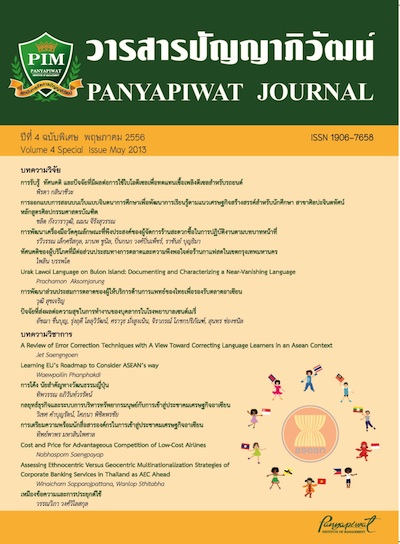Learning EU's Roadmap to Consider ASEAN's way
Main Article Content
บทคัดย่อ
Abstract
The Association of Southeast Asian Nations (ASEAN) is climbing to be the further level of economic competitiveness ratified a Charter as ASEAN Economic Community (AEC) with a single market in trade and production base. Since ASEAN is a new player of regional integration, ASEAN has been suggested to apply a roadmap of the European Union (the EU), the most effective economic integration, nowadays. However, there are a couple of big differences between the EU and ASEAN, probably indicate the unsuitability in adopting the EU's way.
The author accumulates critical details of both the EU and ASEAN with the criticisms to consider dim possibilities of the young institution of countries to follow the powerful giant's path as an Economic Union, ranging from distinguishing forms of economic integration, illustrating their historical backgrounds and demonstrating other dissimilarities between the EU and ASEAN. Moreover, this article indicates some recommendations for ASEAN to handle with the coming, intensive changes as a result of becoming stronger AEC in 2015.
Keywords: The Association of Southeast Asian Nations (ASEAN), The European Union (the EU), ASEAN Economic Community (AEC) and economic integration
บทคัดย่อ
สมาคมประชาชาติแห่งเอเชียตะวันออกเฉียงใต้ (อาเซียน) กำลังจะก้าวข้ามไปสู่การรวมตัวทางเศรษฐกิจในระดับที่สูงขึ้น ในนามของ ประชาคมเศรษฐกิจอาเซียน โดยมี หลักการของการเป็นตลาดและ แหล่งการผลิตร่วมในภูมิภาค อันเนื่องมาจากอาเซียนเสมือนเป็นเด็กใหม่ในการรวมตัวกันทางเศรษฐกิจ จึงเกิดคำแนะนำให้ประชาคมเศรษฐกิจอาเซียนประยุกต์ใช้แผนการดำเนินการของสหภาพยุโรป ซึ่งเป็นการรวมตัวทางเศรษฐกิจที่ประสบความสำเร็จมากที่สุดในปัจจุบัน อย่างไรก็ดี สหภาพยุโรปและอาเซียนมีข้อแตกต่างอยู่หลายประการ อันเป็นนัยสำคัญที่สื่อถึงความไม่เหมาะสมที่อาเซียนจะนำแผนและกลยุทธ์ในการรวมตัวกันทางเศรษฐกิจของสหภาพยุโรปมาประยุกต์ใช้
ผู้เขียนบทความวิชาการได้ทำการรวบรวมข้อมูลและเหตุปัจจัยที่สำคัญในการพิจารณาความเป็นไปได้ที่อาเซียนในฐานะน้องเล็กของการรวมตัวทางเศรษฐกิจ กับยักษ์ใหญ่แห่งอำนาจ อย่างเช่น สหภาพยุโรป นับตั้งแต่ การระบุให้เห็นความแตกต่างของการจัดตั้ง การรวมกลุ่ม ในแง่ของประวัติความเป็นมาของการจัดตั้ง และปัจจัยความแตกต่างอื่นๆ ที่สำคัญระหว่าสหภาพยุโรปและอาเซียน นอกจากนั้นผู้จัดทำยังได้ทำการระบุข้อแนะนำต่างๆในการรับมือกับความเปลี่ยนแปลงที่อาจจะเกิดขึ้นหลังการรวมตัวเป็นประชาคมทางเศรษฐกิจ เพื่อให้ภูมิภาคอาเซียนกลายเป็นประชาคมที่มั่นคงในปี ค.ศ.2015 ที่กำลังจะมาถึง
คำสำคัญ: สมาคมประชาชาติแห่งเอเชียตะวันออกเฉียงใต้ (อาเซียน) สหภาพยุโรป ประชาคมเศรษฐกิจอาเซียน การรวมตัวกันทางเศรษฐกิจ
Article Details
“ข้าพเจ้าและผู้เขียนร่วม (ถ้ามี) ขอรับรองว่า บทความที่เสนอมานี้ยังไม่เคยได้รับการตีพิมพ์และไม่ได้อยู่ระหว่างกระบวนการพิจารณาลงตีพิมพ์ในวารสารหรือแหล่งเผยแพร่อื่นใด ข้าพเจ้าและผู้เขียนร่วมยอมรับหลักเกณฑ์การพิจารณาต้นฉบับ ทั้งยินยอมให้กองบรรณาธิการมีสิทธิ์พิจารณาและตรวจแก้ต้นฉบับได้ตามที่เห็นสมควร พร้อมนี้ขอมอบลิขสิทธิ์บทความที่ได้รับการตีพิมพ์ให้แก่สถาบันการจัดการปัญญาภิวัฒน์หากมีการฟ้องร้องเรื่องการละเมิดลิขสิทธิ์เกี่ยวกับภาพ กราฟ ข้อความส่วนใดส่วนหนึ่งและ/หรือข้อคิดเห็นที่ปรากฏในบทความข้าพเจ้าและผู้เขียนร่วมยินยอมรับผิดชอบแต่เพียงฝ่ายเดียว”
เอกสารอ้างอิง
AEC Blueprint. (2012). Retrieved September 25, 2012, from http://www.thai-aec.com/aec-blueprint
Amornvivat, S., et al. (2012). Insight: Business Opportunities for Services Sector under the AEC, Journal of Siam Commercial Bank, Economic Intelligence Center.
Angresano, J. (2004). European Union Integration Lessons for ASEAN+3: the Importance of Contextual Specificity, Journal of Asian Economics, p. 920.
Beeson, M. (2005). Rethinking Regionalism: European and East Asian in Historical Perspective,Journal of European Public Policy, 12(6).
Chuen, J. T. W. (2003). An Asian Union - Limitations: Options and Constraints, Asia Europe Journal,1(2), p. 163-166.
Curveys, L. (2012). Contrasting the European Union and ASEAN Integration and Solidarity. CAS Discussion Paper, Antwerp: Centre for ASEAN Studies. p 2, 6-7.
Hill, C, W. (2009). Global Business Today. 6th ed. New York: McGraw-Hill.
Murray, P. (2008). Globalization, development, and integration: Model Europe? Reflections on the EU as a Model of Regional Integration. Palgrave: MacMillan.
Nelson, R. M.. et al. (2011). Greece's Debt Crisis: Overview, Policy Responses, and Implications. Congressional Research Service. Retrieved October 10, 2012, from http://www.fas.org/sgp/crs/row/R41167.pdf
Petchsiri, A., Sutthisripok, P., and Thontiravong, P. (2002). Comparative Regional Integration:ASEAN and the EU, Interdisciplinary Department of European Studies. Bangkok: Chulalongkorn University.
The European Union. 2012. Retrieved October 10, 2012, from http://en.wikipedia.org/wiki/Eu
Thepchatri, P. (2012). ASEAN Community. Bangkok: Sematham.


